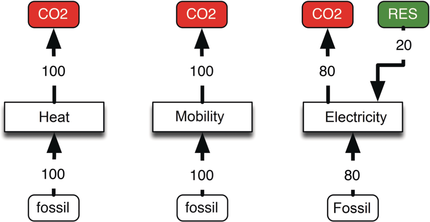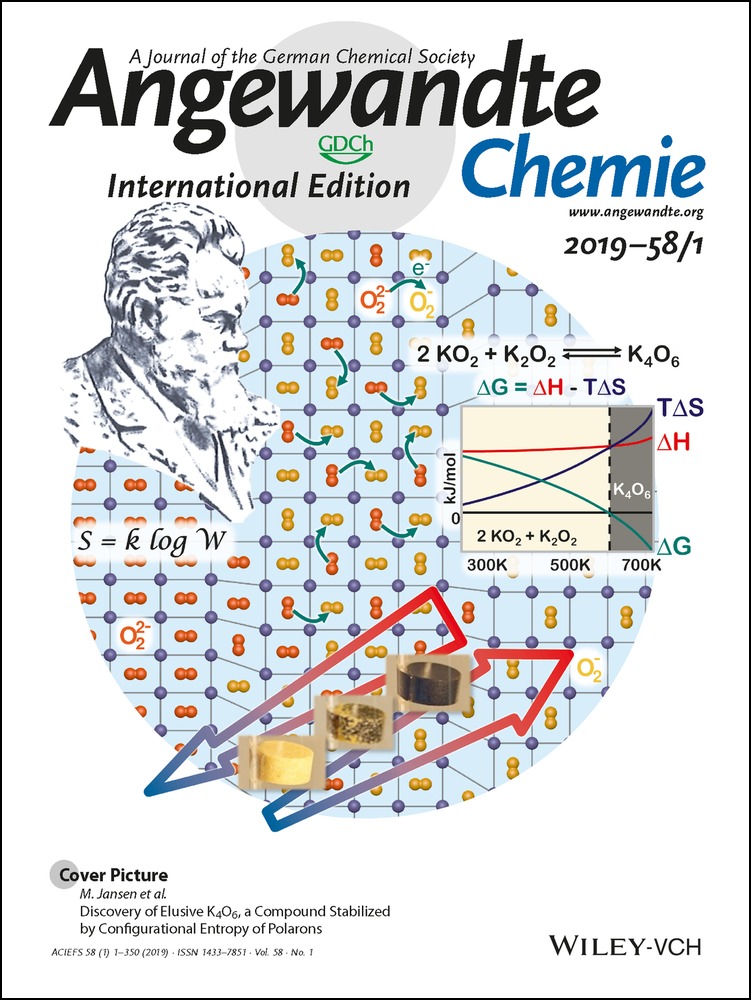Put the Sun in the Tank: Future Developments in Sustainable Energy Systems
Graphical Abstract
The conversion of energy systems toward sustainable solutions has been progressing for several years. The effect on protecting the climate can now be estimated through new projections and is presented here for the European Union. The results are compared to the goals of the Paris Climate Agreement and show that additional, new and qualitative measures must be taken.
Abstract
The conversion of energy systems toward sustainable solutions has been progressing for several years. The effect on protecting the climate can now be estimated through new projections and is presented here for the European Union. The results are compared to the goals of the Paris Climate Agreement and show that additional, new and qualitative measures must be taken.
Steps are being taken to convert our energy systems in order to avoid greenhouse-gas emissions. Leading the way is the technical-economic maturity of the physical converters (photovoltaics (PV), wind turbines) of sun energy into electrical current. From this it may be inferred that the conversion of the energy systems is happening through decarbonization—that is, by forgoing the use of carbon as a material energy carrier. However, volatility from the use of PV and wind turbines on system-relevant scales highlights the limits of strain the electrical system can handle. This effect is dampened through stable renewable energy resources (RES) such as biomass and hydropower. Solutions with storage devices1 such as batteries are already in use although they cannot be scaled to the dimensions of an entire electrical system. But this scale is available2 through chemical energy conversion (CEC). Its central mechanism is the conversion of electrical current into hydrogen which can be used to make other molecular products that are easily transported and stored. With this, the goal of a decarbonization is partially relinquished and a technical carbon cycle becomes part of a sustainable energy system. The carbon cycle consists of a subsystem for the collection and treatment of CO2 and a further system of CEC processes that convert the CO2 and hydrogen to new energy carriers. This family of procedures4 will be denoted with the term carbon capture and use (CCU). The goal of defossilization must remain, however, in order to keep the technical carbon cycle as small as possible. This condition follows from the significant decrease in process efficiency5 when RES are transformed into material energy carriers.
In order for CEC and heat generation to effectively stabilize energy systems, a holistic consideration6 is required with energy exchange between the sectors of electricity, mobility, heat and material synthesis. This perspective will also eliminate the objection7 of a possible “double-counting” through reduced CO2 emissions. Until now CCU has often been used to refer to chemical manufacturing4, 8 in connection with the replacement of fossil fuel sources. As attractive as this option is, its potential for reducing greenhouse gas emission in a climate-relevant way is limited. This part of CCU will become strategically meaningful9 when fossil resources for the chemical industry become scarce. In energy systems with closed material cycles, CCU processes play an indispensable role for the integration of basic industrial processes which cannot function without the use of carbon or the emission of CO2 (e.g., cement production, steel industry). In this context, however, CCU is seen as part of an energy system where the main components are electricity, mobility, and heat.
An alternative to this complex approach is the combination of RES and fossil carriers coupled with a sequestering of the resulting CO2 in the geosphere10 by carbon capture and storage (CCS). This system is significantly more simple, requires less energy and can be realized with today's technology on an effective scale and in a timely way. A decisive disadvantage of this cost-effective solution, however, is that it is not sustainable. The carbon cycle is not closed and the long term consequences for the geosphere may not be manageable.
The individual approaches are compared in Figure 1; the numbers were chosen to illustrate the relative orders of magnitude. In today's model, the sectors are separated and RES are used to generate electricity—for 20 units of RES, 20 units of CO2 emission are saved. A large number of RES are required in the CCU Model B and the sectors are coupled. In addition to the final emissions from the mobility sector, a further 50 units of CO2 are generated from other stabilized sectors. The necessary CCU processes alone require 200 RES units which is more than the direct use of RES in all other sectors (170 units). In total, for 470 RES units, 250 CO2 units are saved. This model only becomes generally sustainable through a feedback of the CO2—discounting unavoidable CO2 sources from materials manufacture—through collection from point sources and collection through biomass or direct air capture (DAC).11 In this case the CCU option becomes cyclic but the consumption of RES increases even further. In Model C, CCS is used to avoid the emission of CO2 and the low energy use of this technology is covered by 20 RES units. 50 CO2 units remain as residual emission after the input of only 190 RES units which are mainly used directly in the different sectors. This model, however, cannot be made sustainable because it does not close the carbon cycle. The technological building blocks for carbon capture and transport in Models B and C are comparable so that Model C may be considered a technological bridge to Model B until adequate RES become accessible. With this model, more time is made available for the further adaption of the energy systems. However, the long-term risks associated with the utilization of the geosphere will remain.
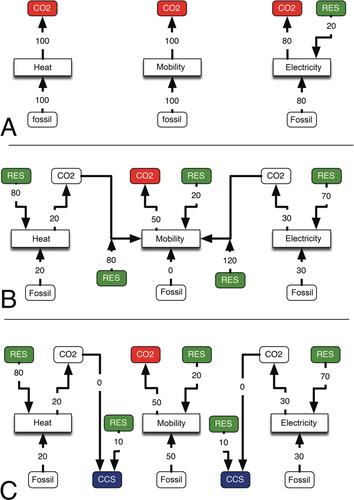
Structures of energy systems. The numbers are arbitrary units of account. Process and transport losses are not incorporated. The efficiency factors are 2.5 for electric driving and 4.0 for CCU. (A) is today's structure, (B) a linear CCU model, and (C) is a CCS model.
The debate surrounding CCU versus CCS takes place with intensity and emotion (“it is a monstrous thermodynamic crime to reduce CO2”, to quote Paul Fennell in Ref. 12). A central part of this debate is the evaluation of efficiency in the energy-conversion-process chains. This field suffers from the absence of a standard method for defining system boundaries and from the lack of validated parameters. The current substitute for the latter are specifications based on varied assumptions.
The debate has developed into a stumbling block for the restructuring of the energy system5, 13 because essential provisions that insure flexibility6 in the electric system are dependent on the outcome. In this case, the proposal of proceeding in both directions to arrive at the planned reduction of CO2 is apparently not beneficial.
The necessity of eliminating this hurdle from the development of the energy system results from considering the progress we have made thus far. The aggregate numbers for the European Union are displayed in Figure 2.
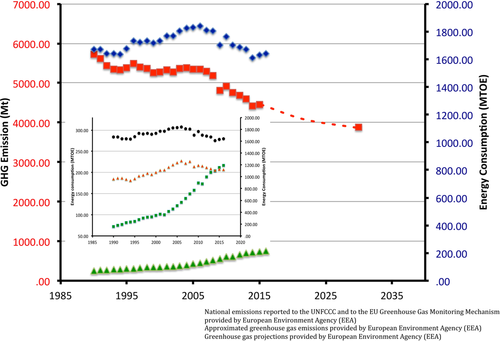
Data on the development of the EU energy system. The insert compares the total energy consumption (black) with the amount of imported energy carriers (including uranium, brown) and renewable energies (green). The development is also shown in the main graphic with a different timescale.
The development of energy consumption (blue, right axis) shows that today's energy use is similar to that of 25 years ago. This non-linear development is surprising because the economy and consumption have grown. The improvement in energy utilization is likely a consequence of the change in economic structure resulting from globalization. A further indication is the growing share of energy devoted to mobility and transport. Greenhouse-gas emission (red, left axis) followed the energy consumption curve until ten years ago, when it markedly declined. This development is likely due to a decrease in the share of production from economic performance coupled with a decrease of the amount of coal in the energy mix as well as to increased use of gas as an energy carrier, to the improved efficiency of the economy and to a variety of other factors which will not be deciphered and interpreted here. The increased use of RES (green, right axis) has also made a significant contribution, although the steep increase of the last ten years is slowly tapering off. This is shown by the inset together with the development of the dependence of imported energy, which has grown considerably. The reason for this is the shift in energy mix away from coal and toward oil and gas. The EU has not only modified the source of its greenhouse gas emissions through a change in economic structure—the progress toward sustainability has advanced so far that it is now apparent in the development of greenhouse gas emissions.
The European Environment Agency has used the reports of all member states on their steps to reduce greenhouse gases to predict the trend for the next 15 years. The conclusion is that the tendency toward the reduction of greenhouse gas emission will continue to increase slightly (Figure 2). A 32 % reduction by 2035 is expected with respect to 1990 and will result, therefore, in a failure to meet the target of 40 %. Figure 2 also shows that this undesirable outcome will be amplified by 2050 and that the climate target of 85 % reduction will be missed altogether. As a consequence, the figure shows additional and drastic measures are needed to boost the rate of change of our energy system. A mere linear increase in RES use will not be adequate.
And so the task remains of designing a sustainable energy system in a comprehensible way.14, 16 Building on the changes we have already implemented, we should employ as many current technologies and infrastructural elements as possible while not putting strain on such resources as biomass, land use, and water reserves. Also, the requirement that human activity avoid energy consumption should be minimized. The timeframe available to sufficiently reduce the production of greenhouse gases in a sustainable way is defined by the emission of 1000 Gt of CO2.
According to our current state of knowledge, this complex cumulative goal can only be reached through the massive application of renewable energy in the form of electricity from photovoltaics17 and wind in conjunction with improved efficiency in all energy sectors (for example heat use and the production of electricity). The future development of the renewables will also have to be severely accelerated.5 For this development to take place, the problem of the spatial and temporal disjunction of RES with respect to demand must be solved on a large scale. RES is currently considered to be mainly a source of local electrical energy which is distributed in power supply lines. In this way, electrical energy can be used immediately within the power supply system without conversion losses—this use of local RES is a central element of every sustainable energy system. However, strategies to enable flexible energy use6 are possible and should be used to their greatest extent.
In order to further facilitate this strategy, however, a reassessment of RES is required. Until now, RES has been considered a valuable type of energy that is to be used in a frugal way with maximum efficiency. But flexibility causes this efficiency to suffer and generates additional costs—these measures have, therefore, been largely avoided. The current assessment of RES ignores the fact that consumption dependent costs (“fuel costs”) are absent. In particular with RES, there are infrastructure costs for the converters and distribution costs which are similar to fossil-based electricity. The further technical development of the converters as well as simplification of political expenditures (taxes, subsidies, charges) will help minimize infrastructure costs. In addition their use in areas with high incoming solar radiation is advisable. For Europe18 this is the case on the coasts and in the south, but less so in the regions of high consumption—this makes RES more costly.
Thus, the main challenge of planning a stabile energy system centers on making RES transportable. On the scales we need to employ (Figure 2) this is only possible through the use of chemical energy carriers. If this can be done, the subsystem of local RES can be expanded through a subsystem of remote RES that are suitable for transport and storage. Looking again at Figure 2, it can be seen that the EU currently imports the majority of its energy. If it is assumed that in the future the EU produces its domestic energy with local RES and also profits from increased efficiency, imported energy should consist of remote RES. As an illustration, energy from the sun is converted into material energy carriers in the regions of high solar radiation and low energy consumption. The energy is then transported in tanks to any place it is required, in complete analogy to the current transport of fossil energy carriers. This idea is not new and was proposed, for example, by the DESERTEC Initiative but with the unrealistic assumption of transport in power lines.
The chemical energy carriers may be chosen in such a way that results in a closed carbon cycle. Or, carbon-free energy carriers may also be used. It begins with hydrogen, the universal form of material energy storage, which we can already generate in a sufficient manner. Table 1 gives an overview of the possibilities.
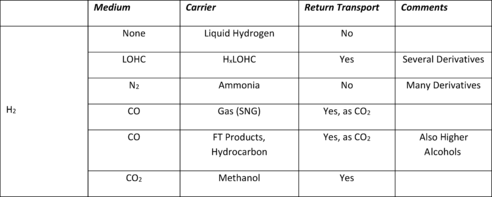
As the table shows, in some cases the storage medium must be transported back to the place of synthesis in order to close the material cycle. If nitrogen is used as the carrier, this is not necessary. However, if it is used in oxidized form,20 great care must be taken to avoid the emission of greenhouse gases such as NOx and N2O that have a much greater potential to trap heat than CO2. A discussion of the advantages and disadvantages of this option would go beyond the scope of this work. The author supports an inclusive approach to technology and expects that all options have the possibility of being implemented in an industrial setting. Therefore, relevant, energy-related research should expressly promote the development of all options in order to contribute to Europe's technological leadership role in the new energy systems. At the current time, however, this development is happening rapidly in Asia.21
The rejection of the concept of material regenerative energy carriers is of the same origin as the debate on the use of CCU. At its core the cause is the over-valuing of process efficiency (for example potential CO2 reduction) and is in response to the unfounded notion of the unique significance of RES. And it is to the detriment of what is actually relevant: system efficiency. The target criterium is, of course, the sustainability of the entire system. For this reason a comparison cannot be made between nonsustainable systems and their efficiency (costs) on the one hand and a sustainable system on the other. Such analogies play a large role in the rejection of CCU technologies. The necessity remains to shape the cost structure in such a manner that energy is made available to all institutional and private members of society in an unhindered and reasonably priced way. Technical developments and especially the formulation of basic parameters contribute to this aspect, but will not be discussed further here.
The development of chemical technologies and of the underlying catalysis19 will enable improved efficiencies for the individual processes. The considerations in Figure 1 indicate that decisive improvement of economic figures for RES can be reached with enhanced processes and a flexible combination of decentralized and centralized subsystems. At the same time, our current state of knowledge is adequate9 to commence with an upscaled implementation of demonstrative models. A precondition of this, however, is the general understanding that a stabile, sustainable energy system requires a combination of local and remote sources of RES. In order to serve this purpose the structure of the material (remote) RES is chosen such that they are compatible with current applications (internal combustion engines, turbines) and infrastructure (transport and distribution systems). An incentive for tolerating unavoidable higher costs is the further application of synthetic energy carriers which can avert the detrimental effects of their own use, such as local emission from combustion engines. However, the dramatic reversal toward new basic technology as is, for example, currently underway in Japan21a can hardly be seen as a model for Europe.
The analogy between material RES from remote sources and fossil-based carriers is shown in Table 2. What is initially made clear is that the number of process steps needed for the development and use of the two kinds of carriers is the same. Remarkable, however, is the exception of pure hydrogen, although the contracted processing chain is more than compensated for by difficulties with handling. Table 2 puts into perspective the discussion of the ostensible disadvantages of material, regenerative energy carriers when compared with fossil-based carriers by highlighting unfavorably long processing chains. Here energy from the sun is assumed as a mutual reference basis. The significant steps of generation and consumption of material energy carriers are very similar even if the individual conversions are of different chemical and physical nature.
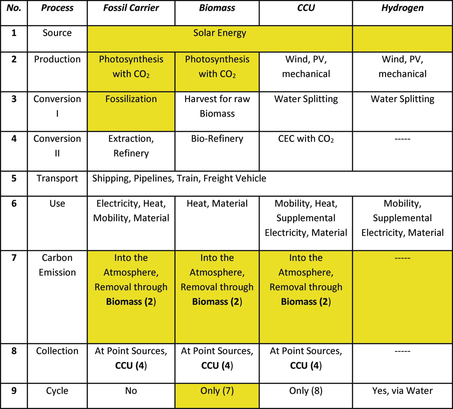
The colored fields in Table 2 are free of financial costs so that the use of the fossil-based energy carriers becomes apparently more economical. However, the current cost structure of the fossil-based and regenerative carriers does not reflect this commonality. This may be due to the fact that nature's contribution to fossil-based energy carriers was made in the prehistoric past. The CCU carriers show the longest, consumer-financed processing chain. At the same time the considerable amounts of energy needed to overcome the kinetic energy barriers—which are in addition to thermodynamic energy requirements—accumulate and require excessive amounts of easily accessible RES. As long as the RES are erroneously attributed special value, the option of the global transport of remote RES, which are decisive for the functioning of the entire energy system, has no realistic chance of success.
The advances in the conversion of the energy systems that have been made to date are, according to projections, not adequate to reach the targets of the Paris Agreement. The necessary conceptual expansion of developmental planning requires a conversion of primary electricity into energy carriers suitable for transport and storage on the scale of the entire energy system. The emergence of a technical carbon cycle will result in the development23 of a CO2 economy. It will then become the task of chemistry to provide an integral part of the energy system in a timely and qualitative manner that will allow for an economical and secure handling of synthetic, material energy carriers on the scale of today's petrochemical industry. The most urgent goal of research is the reduction of today's still significant energy losses caused by insufficient optimization of reaction kinetics. But in order to achieve this the divide between conceptual knowledge of catalytic reactions24 and actual technical realization must be bridged. The developments of scaling valuable raw-material usage, material synthesis, and other processes resulting from advances in basic research are of the highest priority and the multiplicity of immediately necessary chemical conversions (see Table 1) now requires us to concentrate on the inherent scientific challenges. Furthermore, the field of chemistry should in addition cover a broad range of activities in order to increase energy conversion efficiencies. The same basic conditions for the above-mentioned work on scalability are also applicable for new solutions involving materials and processes. The discussion of the subject of technical efficiency should constrain neither the necessary efforts in chemical research nor the development of synthetic, material energy carriers. This topic does not go far enough if the actual goal of the Energiewende is the conversion of energy supplies into sustainable processes on the basis of renewable electricity. The overarching goal of this change remains a systemically efficient use of energy—it is an ambition that can only be reached by the consumer in his socioeconomical environment. It is science and research that will provide the necessary options for doing so.
Conflict of interest
The authors declare no conflict of interest.



